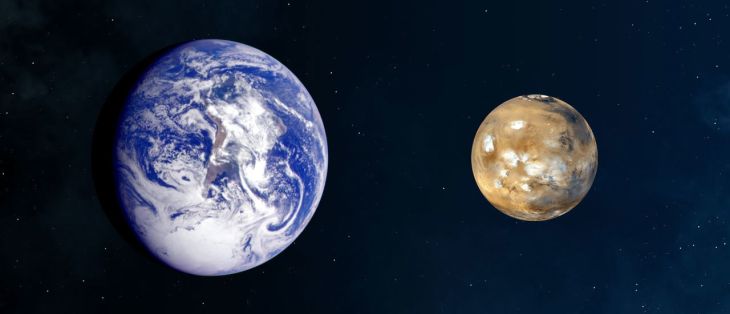
Earth’s distance to Mars varies between 55 and 400 million kilometres, but that doesn’t stop it influencing our oceans. (Photo not to scale)
Scientists from the Universities of Sydney and Sorbonne University have used the geological record of the deep sea to discover a connection between the orbits of Earth and Mars, past global warming patterns and the speeding up of deep ocean circulation.
They discovered a surprising 2.4-million-year cycle where deep currents wax and wane which, in turn, is linked to periods of increased solar energy and a warmer climate.
The study, published in Nature Communications, tackles the questions of how geological-timescale climate change affects ocean circulation and how this could help scientists to model future climates outcomes. The researchers looked to find if ocean-bottom currents become more vigorous or more sluggish in a warmer climate.
These cycles are not linked to the current rapid global warming caused by human greenhouse gas emissions.
Lead author ARC Future Fellow Dr Adriana Dutkiewicz from the University of Sydney EarthByte Group in the School of Geosciences and co-authors used more than half a century of scientific drilling data from hundreds of sites worldwide to understand the vigour of deep-sea currents through time.
In a collaboration with Professor Dietmar Müller (University of Sydney) and Associate Professor Slah Boulila (Sorbonne), Dr Dutkiewicz used the deep-sea sediment record to check for links between sedimentary shifts and changes in the Earth’s orbit.
They found that the vigour of deep-sea currents shifts in 2.4-million-year cycles.
These cycles are called “astronomical grand cycles”, predicted to occur due to the interactions of Earth and Mars orbits. However, evidence for this is rarely detected in the geological record.
Dr Dutkiewicz said: “We were surprised to find these 2.4-million-year cycles in our deep-sea sedimentary data. There is only one way to explain them: they are linked to cycles in the interactions of Mars and Earth orbiting the Sun.”







